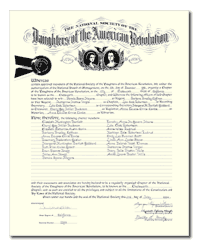
|
The Chapter held an Organizing Party on Dec.10,1998. There were 14 organizing
members; Mrs. Warren B. Meyers, organizing Regent.
The Chatsworth Chapter, National Society of the Daughters of the American Revolution (NSDAR or DAR), was officially approved by the National board as a newly organized chapter on Feb.6, 1999.
Click on the image of the Chatsworth Chapter, NSDAR, Charter at the right to view in full.
|
 |
 |
CHATSWORTH HISTORY
Chatsworth is one of the oldest communities in the northwest corner of the San Fernando
Valley. Nestled against the Simi Hills and the Santa Susana Mountains,
at the foot of the Santa Susana Pass, it is the gateway to the Simi Valley.
Its long and colorful history begins with the prehistoric man who came to the area
to perform ceremonial rituals, which dotted the coastal landscape. Later, Native
Americans had a village here. The name of the village is lost, but evidence
of Fernandeño, Gabrielino, and Chumash Indian tribes abide in the rock-strewn landscape.
The mail between
the missions went over the Santa Susana Pass traveling the El Camino de Santa
Susana y Simi--or the way of Santa Susana and Simi. Later the stagecoach crossed
the pass connecting the valley to points north. A relay station was located
in the mountains above Chatsworth where tired horses were exchanged for fresh
ones and members of the Encino-based de la Osa family operated the relay station.
|
Settlers Ann and Neils Johnson came
to the area in the 1870s and carved a home from the wilderness. Mrs. Johnson
became the first English-speaking woman to live in the San Fernando Valley and
her daughter, Emma Johnson Graves, is said to be the first blue-eyed baby born
in the valley. Following the Johnson's, many families homesteaded on the land
available outside the mission land grant, forming the beginnings of a community.
A sub-division map for a town
called Chatsworth Park was filed in 1888. It was laid out in 10-acre plots for
family farming and was named for the Duke of Devonshire's palatial estate in
England. Reflecting its English heritage, the Chatsworth Chamber of Commerce
uses the Duke of Devonshire's coat-of-arms as its insignia with the permission
of the 10th Duke.
Providing a market for the agricultural
products of Chatsworth, the Southern Pacific Railroad was completed to Chatsworth
around 1893. A station was built soon after and in 1904 tunnels were completed
through the mountains allowing the trains to connect with northern areas. The
town stayed agricultural for many years, gradually dropping the word "Park"
from the name. When the Owens River water became available for irrigation, Chatsworth
residents voted to become a part of greater Los Angeles, changing to a community
rather than a separate town.
|
The movies discovered Chatsworth about
1912. Because of the scenic rocks and rugged landscape, Chatsworth became
a popular location for westerns. Not only were many scenes filmed in the
community but also on the Iverson Movie Ranch. Later, television cameras
and crews also used Chatsworth and the surrounding rocks and hills as a backdrop
for many western series. The area continues to attract movie and television
location crews and they can often be seen working in the community.
|
The San Fernando Valley experienced a population
explosion after World War II when servicemen returned from the war wanting homes.
Chatsworth grew and prospered gaining many new residents, schools, industries,
churches, and a library.
High tech industry became plentiful
in the industrial park, which opened in the 1960s and presently condominiums
have replaced the citrus and walnut groves which once dominated the landscape.
Horse ranches are fewer and much smaller but still available in the area. Several
national historical monuments are included within the boundaries of the community
that make note of its history.
The 670 acre Santa Susana Pass
State Historic Park surrounds the community on the west. Change has become a way of
life for urban Chatsworth residents who are preserving as much as possible,
the scenic area and small-town atmosphere that brought people to this beautiful,
historically rich part of the valley.